
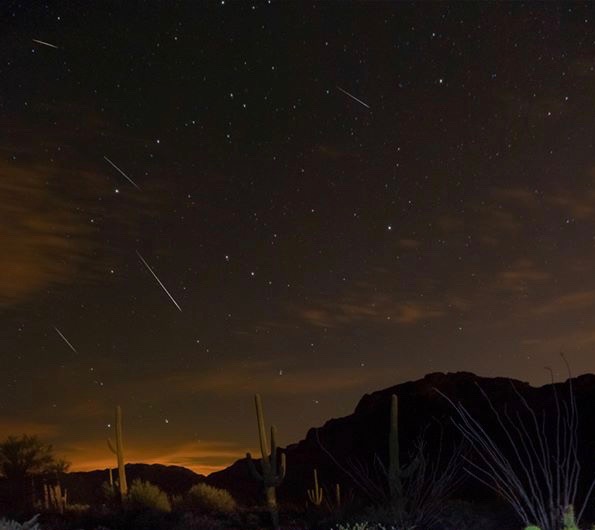
Composite image of Draconids seen near Tucson, Arizona, in 2013, by our friend Sean Parker Photography.
October’s Draconid meteor shower – sometimes called the Giacobinids – is gearing up, with the Draconids’ expected peak night to fall on October 7, 2020. This week’s waning gibbous moon won’t rise until mid-to-late evening, providing a few to several hours of dark sky, starting at nightfall. Unlike many meteor showers, the best time to view the Draconids is during the early evening hours. The Draconid shower is usually a sleeper, rarely offering more than five meteors per hour. But watch out if the Dragon awakes! The Draconid meteor shower produced awesome meteor displays in 1933 and 1946, with thousands of meteors per hour seen in those years. European observers saw over 600 meteors per hour in 2011.
The Draconid shower is active between October 6 and 10. As noted above, the best evening to watch is likely October 7; try the evenings of October 6 and 8 also. Notice the word evening. This is one shower you don’t have to stay up late to see. Once again, we encourage you to start watching first thing at nightfall. Be sure to find a dark, open, country sky.
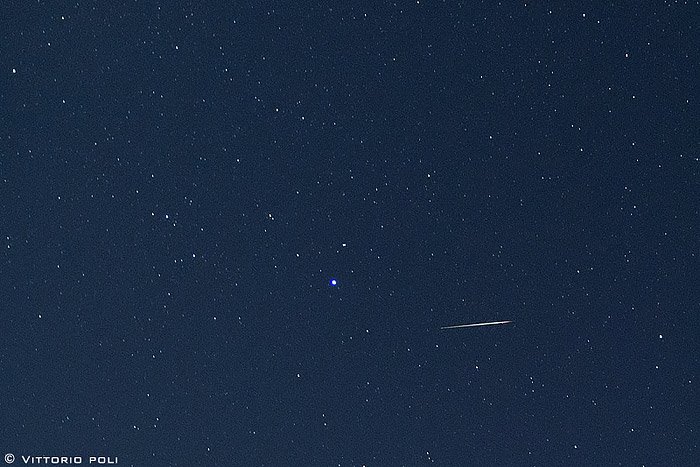
Draconid meteor seen from Italy in 2011, flying near the bright star Vega in the constellation Lyra. The stars Eltanin and Rastaban in Draco – near the radiant of the Draconid meteor shower – shine close to Vega. Image via Vittorio Poli.
How many Draconids will you see? In general, the Draconids aren’t a rich shower, unless their parent comet is nearby. They typically produce only about five meteors per hour.
This annual meteor shower happens when Earth in its orbit crosses the orbital path of Comet 21P/Giacobini-Zinner. Debris left behind by this comet collides with the Earth’s upper atmosphere to burn up as Draconid meteors. This comet has an orbital period of about 6.6 years. It’s about six times more distant at its farthest point from the sun than at its nearest point. At aphelion – its most distant point – it’s farther out than the planet Jupiter. At perihelion – its closest point to the sun – it’s about the Earth’s distance from the sun.
On rare occasions – when the peak of the shower coincides with the comet’s perihelion – this shower has been known to rain down hundreds or even thousands of meteors in an hour.
The last perihelion of the comet was September 10, 2018. On that same night, Comet 21P/Giacobini-Zinner came closer to Earth than it had in 72 years. Consequently, the Draconids had an outburst in 2018. We posted best pics of the comet as it swept safely past.
Because this comet has an orbital period of nearly seven years, the next perihelion won’t come until 2025. So we’re not expecting any outburst this year, in 2020. But, then, no one really knows for sure.
For people who enjoy meteor showers, that’s part of the fun! As a wise person once said, meteor showers are like fishing. You go, and sometimes you catch something.

View larger. | Greg Hogan in Kathleen, Georgia, U.S., wrote on September 10, 2018: “I was able to grab a shot of Comet 21P/Giacobini-Zinner (top left), alongside Messier 37 (star cluster, bottom right). The comet looked like a little fuzzy spot through the ‘scope.” Thanks, Greg! See more photos of Comet 21P/Giacobini-Zinner in 2018.
Where is the radiant point of the Draconid shower? The Draconids are best in the evening, instead of before dawn, because the winged Dragon, the shower’s radiant point, flies highest in the sky at nightfall.
As night passes – no matter where you are on Earth – the radiant point sinks lower in your sky.
The Draconid meteors, when traced backward, radiate from the head of Draco the Dragon, near the stars Eltanin and Rastaban.
You don’t have to locate Draco the Dragon to watch the Draconids. These meteors fly every which way through the starry sky. But finding Draco is fun, and relatively easy.
More about the Draconid meteor shower radiant point here.
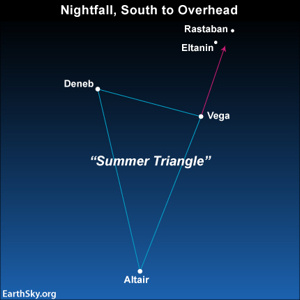
Draconids radiate from near the Dragon’s Eyes: the stars Eltanin and Rastaban. Familiar with the Summer Triangle? Draw an imaginary line from Altair through Vega and it will point to them.

Here’s a more detailed view of the radiant point of the Draconid meteor shower. It’s highest in the north at nightfall in early October.
The Draconids have a rich history. Most meteors in annual showers are named for the constellation from which they appear to radiate, in this case Draco the Dragon.
Draco’s meteors, however, defy convention by sometimes also being called the Giacobinids, to honor the role this comet played in the history of astronomers’ understanding of what meteors actually are.
Michel Giacobini discovered this comet on December 20, 1900, so the comet received his name. Another sighting in 1913 added Zinner to the comet’s name, which thus became 21P/Giacobini-Zinner. Astronomers in the early 20th century speculated that meteors and comets were related, so of course they tried to link various comets to the spectacular showers of meteors that sometimes rain down in Earth’s sky.
Comet 21P/Giacobini-Zinner was a particularly tempting object about which to make predictions. Remember, it returns every 6.6 years, and its closest point to the sun is about the same as Earth’s distance.
What’s more, Comet Giacobini-Zinner did not disappoint the astronomers.
The Draconid meteor shower produced awesome meteor displays in 1933 and 1946, with thousands of meteors per hour seen in those years.
In October 2011, people around the globe saw an elevated number of Draconid meteors, despite a bright moon that night. European observers saw over 600 meteors per hour in 2011.
The relationship between 21P/Giacobini-Zinner and its meteors – so studied and discussed among professional astronomers in the early 20th century – probably explains why the Draconid meteor shower sometimes goes by the name Giacobinids.
For a taste of history related to this shower, go to the Astronomy Abstract Service from the Smithsonian and NASA and find a 1934 article called The Meteors from Giacobini’s Comet by C.C. Wylie. It’s an account of the famed meteor storm of 1933.
Can you see the Draconids from the Southern Hemisphere? It’s possible. But if you’re so far south that the radiant point in the constellation Draco doesn’t rise above your horizon, or rises only briefly, you won’t catch many.
As seen from the Southern Hemisphere, you would have to be rather close to the equator in order to see Draco’s stars. Suppose you live in northern Australia – say Darwin, Northern Territory, Australia – which is at 12 degrees south latitude. If so, you’d be able to see the stars Rastaban and Eltanin very close to your north-northwest horizon at nightfall in early October (given an unobstructed northern horizon). These stars would set at fairly early evening, and you wouldn’t see the head of Draco again until nightfall the following evening.
Why early evening? It’s because, no matter where you live worldwide, the head of Draco reaches upper transit (highest point in your sky) at around 5 p.m. local time in early October.
Thus, from latitudes in the Southern Hemisphere – even those as far north as northern Australia – you would have a very narrow window for seeing meteors. If you’re in the Southern Hemisphere, and you’re really wanting to see a Draconid, try looking as soon as it gets really dark on October 7 and 8, and don’t expect much.
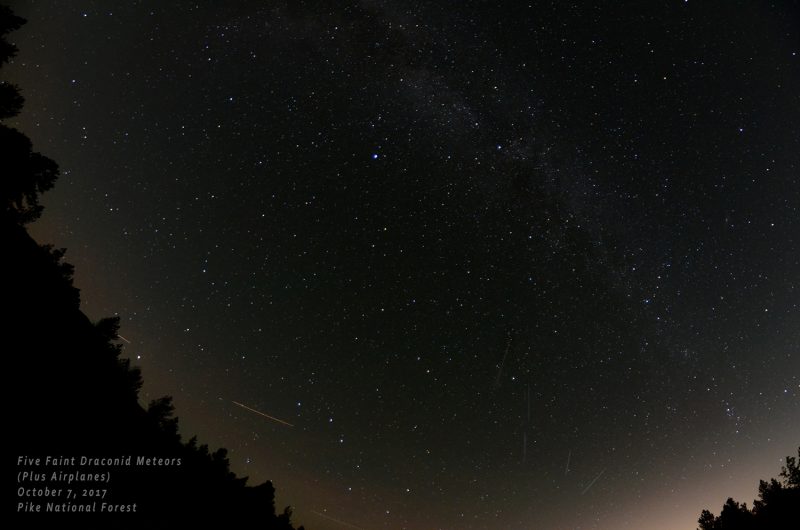
Photo composite – 5 Draconid meteors in less than an hour – on October 7, 2017, from Stephanie Longo at Pike National Forest in Tarryall, Colorado.
Bottom line: In 2020, the Draconid meteor shower – also called the Giacobinids – will probably produce the most meteors on the evening of October 7. Try the evenings of October 6 and 8 also. Don’t wait until after midnight. Watch as soon as it gets dark outside. Find a dark country sky and as much open sky as possible.
EarthSky meteor shower guide for 2020
from EarthSky https://ift.tt/2mOGQCC


Composite image of Draconids seen near Tucson, Arizona, in 2013, by our friend Sean Parker Photography.
October’s Draconid meteor shower – sometimes called the Giacobinids – is gearing up, with the Draconids’ expected peak night to fall on October 7, 2020. This week’s waning gibbous moon won’t rise until mid-to-late evening, providing a few to several hours of dark sky, starting at nightfall. Unlike many meteor showers, the best time to view the Draconids is during the early evening hours. The Draconid shower is usually a sleeper, rarely offering more than five meteors per hour. But watch out if the Dragon awakes! The Draconid meteor shower produced awesome meteor displays in 1933 and 1946, with thousands of meteors per hour seen in those years. European observers saw over 600 meteors per hour in 2011.
The Draconid shower is active between October 6 and 10. As noted above, the best evening to watch is likely October 7; try the evenings of October 6 and 8 also. Notice the word evening. This is one shower you don’t have to stay up late to see. Once again, we encourage you to start watching first thing at nightfall. Be sure to find a dark, open, country sky.

Draconid meteor seen from Italy in 2011, flying near the bright star Vega in the constellation Lyra. The stars Eltanin and Rastaban in Draco – near the radiant of the Draconid meteor shower – shine close to Vega. Image via Vittorio Poli.
How many Draconids will you see? In general, the Draconids aren’t a rich shower, unless their parent comet is nearby. They typically produce only about five meteors per hour.
This annual meteor shower happens when Earth in its orbit crosses the orbital path of Comet 21P/Giacobini-Zinner. Debris left behind by this comet collides with the Earth’s upper atmosphere to burn up as Draconid meteors. This comet has an orbital period of about 6.6 years. It’s about six times more distant at its farthest point from the sun than at its nearest point. At aphelion – its most distant point – it’s farther out than the planet Jupiter. At perihelion – its closest point to the sun – it’s about the Earth’s distance from the sun.
On rare occasions – when the peak of the shower coincides with the comet’s perihelion – this shower has been known to rain down hundreds or even thousands of meteors in an hour.
The last perihelion of the comet was September 10, 2018. On that same night, Comet 21P/Giacobini-Zinner came closer to Earth than it had in 72 years. Consequently, the Draconids had an outburst in 2018. We posted best pics of the comet as it swept safely past.
Because this comet has an orbital period of nearly seven years, the next perihelion won’t come until 2025. So we’re not expecting any outburst this year, in 2020. But, then, no one really knows for sure.
For people who enjoy meteor showers, that’s part of the fun! As a wise person once said, meteor showers are like fishing. You go, and sometimes you catch something.

View larger. | Greg Hogan in Kathleen, Georgia, U.S., wrote on September 10, 2018: “I was able to grab a shot of Comet 21P/Giacobini-Zinner (top left), alongside Messier 37 (star cluster, bottom right). The comet looked like a little fuzzy spot through the ‘scope.” Thanks, Greg! See more photos of Comet 21P/Giacobini-Zinner in 2018.
Where is the radiant point of the Draconid shower? The Draconids are best in the evening, instead of before dawn, because the winged Dragon, the shower’s radiant point, flies highest in the sky at nightfall.
As night passes – no matter where you are on Earth – the radiant point sinks lower in your sky.
The Draconid meteors, when traced backward, radiate from the head of Draco the Dragon, near the stars Eltanin and Rastaban.
You don’t have to locate Draco the Dragon to watch the Draconids. These meteors fly every which way through the starry sky. But finding Draco is fun, and relatively easy.
More about the Draconid meteor shower radiant point here.

Draconids radiate from near the Dragon’s Eyes: the stars Eltanin and Rastaban. Familiar with the Summer Triangle? Draw an imaginary line from Altair through Vega and it will point to them.

Here’s a more detailed view of the radiant point of the Draconid meteor shower. It’s highest in the north at nightfall in early October.
The Draconids have a rich history. Most meteors in annual showers are named for the constellation from which they appear to radiate, in this case Draco the Dragon.
Draco’s meteors, however, defy convention by sometimes also being called the Giacobinids, to honor the role this comet played in the history of astronomers’ understanding of what meteors actually are.
Michel Giacobini discovered this comet on December 20, 1900, so the comet received his name. Another sighting in 1913 added Zinner to the comet’s name, which thus became 21P/Giacobini-Zinner. Astronomers in the early 20th century speculated that meteors and comets were related, so of course they tried to link various comets to the spectacular showers of meteors that sometimes rain down in Earth’s sky.
Comet 21P/Giacobini-Zinner was a particularly tempting object about which to make predictions. Remember, it returns every 6.6 years, and its closest point to the sun is about the same as Earth’s distance.
What’s more, Comet Giacobini-Zinner did not disappoint the astronomers.
The Draconid meteor shower produced awesome meteor displays in 1933 and 1946, with thousands of meteors per hour seen in those years.
In October 2011, people around the globe saw an elevated number of Draconid meteors, despite a bright moon that night. European observers saw over 600 meteors per hour in 2011.
The relationship between 21P/Giacobini-Zinner and its meteors – so studied and discussed among professional astronomers in the early 20th century – probably explains why the Draconid meteor shower sometimes goes by the name Giacobinids.
For a taste of history related to this shower, go to the Astronomy Abstract Service from the Smithsonian and NASA and find a 1934 article called The Meteors from Giacobini’s Comet by C.C. Wylie. It’s an account of the famed meteor storm of 1933.
Can you see the Draconids from the Southern Hemisphere? It’s possible. But if you’re so far south that the radiant point in the constellation Draco doesn’t rise above your horizon, or rises only briefly, you won’t catch many.
As seen from the Southern Hemisphere, you would have to be rather close to the equator in order to see Draco’s stars. Suppose you live in northern Australia – say Darwin, Northern Territory, Australia – which is at 12 degrees south latitude. If so, you’d be able to see the stars Rastaban and Eltanin very close to your north-northwest horizon at nightfall in early October (given an unobstructed northern horizon). These stars would set at fairly early evening, and you wouldn’t see the head of Draco again until nightfall the following evening.
Why early evening? It’s because, no matter where you live worldwide, the head of Draco reaches upper transit (highest point in your sky) at around 5 p.m. local time in early October.
Thus, from latitudes in the Southern Hemisphere – even those as far north as northern Australia – you would have a very narrow window for seeing meteors. If you’re in the Southern Hemisphere, and you’re really wanting to see a Draconid, try looking as soon as it gets really dark on October 7 and 8, and don’t expect much.

Photo composite – 5 Draconid meteors in less than an hour – on October 7, 2017, from Stephanie Longo at Pike National Forest in Tarryall, Colorado.
Bottom line: In 2020, the Draconid meteor shower – also called the Giacobinids – will probably produce the most meteors on the evening of October 7. Try the evenings of October 6 and 8 also. Don’t wait until after midnight. Watch as soon as it gets dark outside. Find a dark country sky and as much open sky as possible.
EarthSky meteor shower guide for 2020
from EarthSky https://ift.tt/2mOGQCC

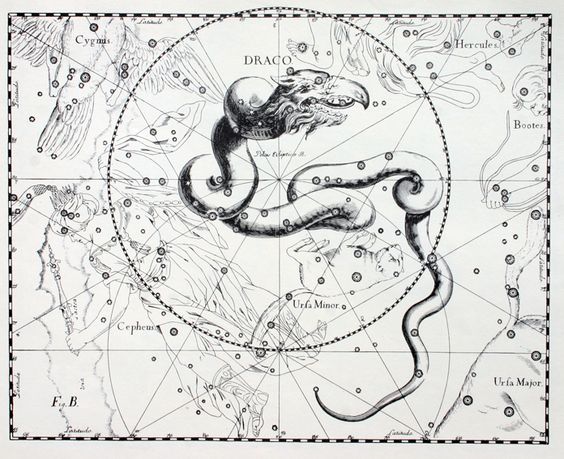
Aucun commentaire:
Enregistrer un commentaire